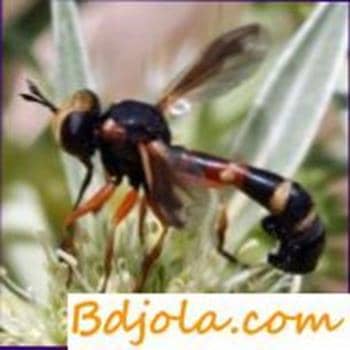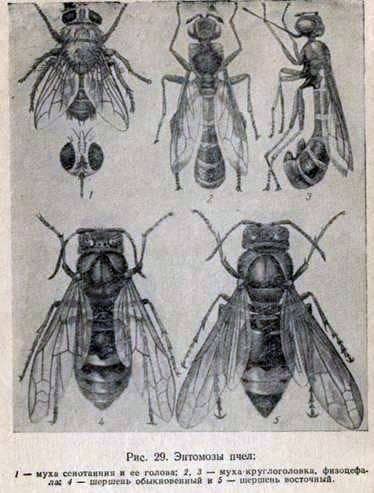
Fizotsefalez – an invasive disease of bee colonies, caused by larvae of the fly-roundhead – Phy-socephala vittata.

The causative agent of the disease. The round-head fly is 11 mm long, has a large round head – in diameter 1.75 mm, with long proboscis, brownish-yellow chest 3.5 mm long, 2.5 mm wide, 6×2 mm wings, 7 mm long abdomen, width 1 mm, the posterior end is thickened to 2 mm. Abdomen black, reddish at the back. The apex of the abdomen and the posterior end of the extreme tergites are silvery. An adult fly occurs more often on flowers of Compositae and crucifers.
The female fly, having a fast flight, overtakes a bee flying out of the hive or working in the field on the flowers and lays an egg on it. A larva emerges from the egg, which penetrates into the body of the bee through inter-segmental membranes and rapidly develops in the abdominal cavity of the bee.
The mature fly larva forms a cocoon-puparium, having an elongated-ovoid shape, a reddish-brown or dark-brown color. Its dimensions are 7.5 x 3.5 mm. A young fly, breaking through a cocoon, and then an intersegmentary partition of a bee, emerges from its abdominal cavity.
The course and symptoms of the disease. The disease manifests itself in the second half of the summer.
Infected bees have a strongly stretched abdomen. Through its inter-segmental membranes, a whitish larva or a dark puparium of the parasite shines through. The larvae and the puparium are flies in the belly of the bees and are felt to the touch. In the morning, soon after sunrise, the bees pull out the weakened, inactive bees and throw them 5-8 m from the hive.
Diagnosis. In a perishing or dead bee, you can find white larvae of fizocephalus filling the entire abdomen. The thin proboscis of the larva extends into the bee’s chest, and the posterior sterigms are visible through the anus.
Control measures. Keep in the cleanliness of the apiary, burning garbage and corpses of bees. The measures of extermination of adult flies-round-headed have not been studied enough.
Карликовые пчелы. Пчела каменщица.
Diseases of bees